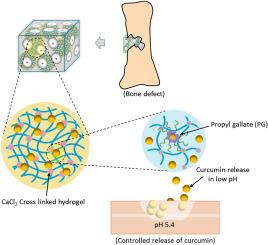具有可调孔隙度的水凝胶集成仿生羟基磷灰石支架,增强姜黄素的输送
IF 4.9
3区 医学
Q1 PHARMACOLOGY & PHARMACY
Journal of Drug Delivery Science and Technology
Pub Date : 2025-09-26
DOI:10.1016/j.jddst.2025.107572
引用次数: 0
摘要
在50岁以上的成年人中,有近50%患有骨疾病,严重的损伤往往超过自然愈合能力。虽然羟基磷灰石(HA)基支架在骨组织工程中显示出前景,但其有效性受到脆性、机械性能差和药物释放不一致的限制。为了克服这些限制,我们开发了一种孔隙率超过70%的多孔仿生支架,集成了由聚丙烯酸、海藻酸钠、羧甲基纤维素、马铃薯淀粉和没食子酸丙酯(PSCPP)组成的ph响应水凝胶。这种支架被设计成在羟基磷灰石中稳定地包裹姜黄素,解决了这些挑战。该系统以双相动力学传递姜黄素:在酸性炎症环境(pH 5.4)中快速释放,在生理pH(7.4)下过渡到持续释放。实验结果表明,在中性pH下,7天内的释放率为3%,而在酸性pH下,累积释放率为90%,证实了其pH响应行为。关键的创新包括pg稳定的姜黄素与淀粉调节释放,PSCPP水凝胶优化pH响应性和肿胀,ha -水凝胶杂交,保持生物活性,同时提高机械强度。体外研究证实支架的生物相容性超过80%的细胞存活率。这种设计结合了机械稳定性和药物输送控制,在需要结构支持和治疗释放的情况下,展示了骨支架应用的有效特性。本文章由计算机程序翻译,如有差异,请以英文原文为准。

Hydrogel-integrated biomimetic hydroxyapatite scaffolds with tunable porosity for enhanced curcumin delivery
Bone disorders affect nearly 50 % of adults over 50, with severe injuries often surpassing natural healing capacity. While hydroxyapatite (HA)-based scaffolds have shown promise in bone tissue engineering, their effectiveness is limited by brittleness, poor mechanical properties, and inconsistent drug release. To overcome these limitations, we developed a porous biomimetic scaffold with over 70 % porosity, integrating a pH-responsive hydrogel composed of polyacrylic acid, sodium alginate, carboxymethyl cellulose, potato starch, and propyl gallate (PSCPP). This scaffold is designed to stably encapsulate curcumin within hydroxyapatite, addressing these challenges. The system delivers curcumin with dual-phase kinetics: a rapid release in acidic inflammatory environments (pH 5.4) and a transition to sustained release at physiological pH (7.4). Experimental results show a release rate of 3 % over 7 days at neutral pH compared to a 90 % cumulative release at acidic pH, confirming its pH-responsive behavior. Key innovations include PG-stabilized curcumin with starch-modulated release, PSCPP hydrogel optimizing pH responsiveness and swelling, and HA-hydrogel hybridization that preserves bioactivity while enhancing mechanical strength. In vitro studies confirm the scaffold's biocompatibility with over 80 % cell viability. This design combines mechanical stability with controlled drug delivery, demonstrating effective features for bone scaffold applications where both structural support and therapeutic release are needed.
求助全文
通过发布文献求助,成功后即可免费获取论文全文。
去求助
来源期刊
CiteScore
8.00
自引率
8.00%
发文量
879
审稿时长
94 days
期刊介绍:
The Journal of Drug Delivery Science and Technology is an international journal devoted to drug delivery and pharmaceutical technology. The journal covers all innovative aspects of all pharmaceutical dosage forms and the most advanced research on controlled release, bioavailability and drug absorption, nanomedicines, gene delivery, tissue engineering, etc. Hot topics, related to manufacturing processes and quality control, are also welcomed.

 求助内容:
求助内容: 应助结果提醒方式:
应助结果提醒方式:


